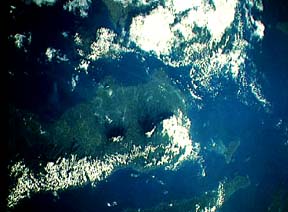Philippine volcano erupts,
spews plume of ash, gas
The Kanlaon volcano in central Philippines erupted on Monday, spewing a column of ash and gas into the sky, the Philippine Institute of Volcanology and Seismology said.
An explosive eruption occurred at the summit vent of the Kanlaon Volcano on Monday afternoon, the institute said in an alert-level bulletin.
"The eruption produced a voluminous plume that rapidly rose to 3,000 meters above the vent and drifted west-southwest," it read.
The bulletin added that the activity means a "magmatic eruption has begun that may progress to further explosive eruptions."
The institute raised the alert level to three on a scale of five.
It also advised villagers within a 6-km radius of the volcano's summit to evacuate, saying that the public "must be prepared for additional evacuation if activity warrants."
The Kanlaon Volcano, which straddles the provinces of Negros Oriental and Negros Occidental on the island of Negros, is one of the country's most active volcanoes, which erupted in June.
Canlaon, Philippines
RECENT ACTIVITY
Location: 10.4N, 123.1E
Elevation: 7,987 feet (2,435 m)
 Photo Credit: Jorgen S Aabech Canlaon is a stratovolcano in the north central part of the island of Negros. It has two summit cones, each with a crater. This photo looks west across northern Negros. Silay, a Holocene stratovolcano is the northern most cone on the island (obscured by clouds). Mandalagan, also a Holocene stratovolcano, has a small plume on clouds off its summit to the southeast (to the bottom left). Canlaon is near the center of the north part of the island.  Expedia Map of the Canlaon area Canlaon has 19 historic eruptions between 1866 and 1993. The eruptions are small to moderate in size (VEI=1-2) and explosive.  Space Shuttle photo STS056-0155-0219. April 15, 1993. Click HERE for information about climing Mt. Kanlaon (external) Sources of Information: Neumann van Padang, M., 1953, Philippine Islands and Cochin China. Catalogue of the Active Volcanoes of the World, International Association of Volcanology, 2, Rome, Italy, 49 p. Simkin, T., and Siebert, L., 1994, Volcanoes of the World: Geoscience Press, Tucson, Arizona, 349 p. |
No comments:
Post a Comment